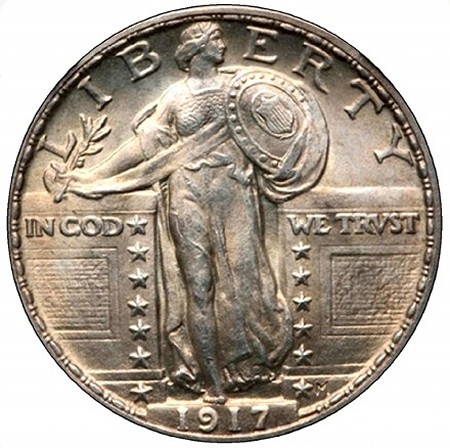PART I. Die Subtypes:
Mid-year Design Modifications:
1917 Standing Liberty Quarter; Type I and Type II
Definition:The below images show the Type I and Type II Standing Liberty Quarter. Both the obverse and reverse of this coin underwent extensive modifications in the year 1917. One noteworthy change was the covering of Liberty’s exposed right breast with chain mail (see image below of the Type II quarter). Urban legend claims that the exposed breast was seen as indecent and created a public outcry. This forced the U. S. Mint to produce a more modest allegorical figure of Liberty.
A different explanation can be found on Wikipedia
(http://en.wikipedia.org/wiki/Standing_Liberty_quarter).
“Roger W. Burdette suggests that this change was not unusual for MacNeil (original designer of the Standing Liberty Quarter), who was increasingly cladding female figures in garments which covered their breasts, as with his statue Intellectual Development, sculpted around that time, and also reflected the deterioration of the international situation in February 1917, as the United States moved towards war with Germany.
The redesign of the obverse has led to an enduring myth that the breast was covered up out of prudishness, or in response to public outcry. Breen states that “through their Society for the Suppression of Vice, the guardians of prudery at once began exerting political pressure on the Treasury Department to revoke authorization for these ‘immoral’ coins”. Ron Guth and Jeff Garrett, in their book on US coins by type, aver that the covering up of Liberty was “a change never authorized by MacNeil”. Numismatic historian David Lange concedes that there is no evidence of outcry from the public, but suggests that the decision to change the coin was “more likely prompted by objections from the Treasury Department.”
On July 9th, 1917 a bill was enacted by Congress authorizing the changes to the Standing Liberty quarter.
TYPE I
In comparing both the obverse and reverse of both types of 1917 Standing Liberty quarters, it becomes obvious that the changes were not made by re-engraving the master dies. Such major changes to both obverse and reverse designs could only have been accomplished by the making of two new galvanos.
TYPE II
.Images are courtesy of Heritage Auctions





